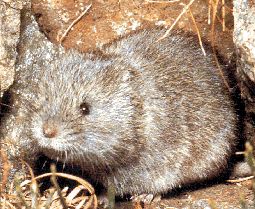Snow mouse
| Snow mouse | ||||||||||||
|---|---|---|---|---|---|---|---|---|---|---|---|---|

Chionomys nivalis |
||||||||||||
| Systematics | ||||||||||||
|
||||||||||||
| Scientific name | ||||||||||||
| Chionomys nivalis | ||||||||||||
| ( Martins , 1842) |
The snow mouse ( Chionomys nivalis ) is a mammal from the subfamily of voles (Arvicolinae). This relatively large and long-tailed vole inhabits the mountains in southern Europe and the Middle East up to an altitude of 4700 m and is also found in the Alps. It predominantly inhabits alpine meadows and heaps of coarse rubble above the tree line. According to the IUCN, the species is considered harmless.
features
The snow mouse is a relatively large and long-tailed vole. The head-torso length is 90-140 mm, the tail length 50-76 mm, the length of the hind foot 17.0-22.5 mm and the ear length 13-19 mm. The animals weigh 19–60 g, rarely up to 68 g. As with all species of the genus Chionomys, the soft and dense fur is light gray on the top with a brownish tinge, the underside is whitish. The tops of the feet and the ears are short white hairy, the tail is also hairy white and also has a white end tassel. The whiskers are also very long, typical of the species, at over 35 mm.
distribution
The distribution area of the snow mouse includes the mountains in southern Europe and the Middle East. The spatially strongly fragmented (disjoint) area stretches from southern Spain over the Pyrenees , southern France, the Alps, the Carpathians and the Balkan Peninsula to the east to Turkey and the Zagros Mountains in Iran and to the south to Lebanon .
habitat
Unlike most voles, the species is bound to soils interspersed with rocks and coarse rock and is the only European vole to be found in the high mountains. The snow mouse populates the Alps at altitudes between 1000 and 4000 m, other mountains up to 4700 m. It predominantly inhabits alpine mats and heaps of coarse rubble above the tree line. Especially in the Mediterranean area, however, the species also colonizes dry and rocky slopes with bushes or loose trees and is already represented there at heights from 125 to 250 m. Occasionally, the animals also inhabit mountain huts and other buildings.
Way of life
Snow mice are active during the day and at night and like to sunbathe. The animals jump and climb very well. They live in small colonies, the burrows are in crevices or flat underground and consist of a living room, a food depot and a droppings place. The entry hole for the building, which is often created next to stones, is protected from the water by an earth wall if the snow melts suddenly. The food, which is probably exclusively plant-based, consists primarily of green parts of plants such as grass, herbs and sedges , and subterranean parts of plants and seeds are also eaten. Snow mice are supposed to "hay" in autumn, that is to say, they should allow parts of plants that have been bitten off to dry in the sun before being stored.
Reproduction takes place from June to the end of September. The gestation period is 20 to 22 days. There are only one or two litters a year with 2-4 youngsters. The newly born young mice weigh about 3.3-4.2 g. The eyes open at 13 days of age. Females born in spring are sexually mature that same year. The lifespan is about 18 months.
Existence and endangerment
The snow mouse is common in suitable habitats. Neither mass multiplication nor greater density fluctuations are known for the species. The world herd is loud IUCN as uncritical ( "least concern"), even in Germany, the species is in the red list out as endangered.
swell
literature
- Stéphane Aulagnier, Patrick Haffner, Anthony J. Mitchell-Jones, François Moutou, Jan Zima: The mammals of Europe, North Africa and the Middle East. The destination guide. Haupt, Bern et al. 2009, ISBN 978-3-258-07506-8 , pp. 198-199.
- Anthony J. Mitchell-Jones, Giovanni Amori, Wieslaw Bogdanowicz, Boris Krystufek, PJH Reijnders, Friederike Spitzenberger, Michael Stubbe, Johan BM Thissen, Vladimiŕ Vohralik, Jan Zima: The Atlas of European Mammals. Poyser, London, 1999, ISBN 0-85661-130-1 , pp. 256-257.
- Erwin Stresemann (founder), Konrad Senglaub (ed.): Excursion fauna of Germany. Volume 3. Vertebrates. 12th, heavily edited edition. G. Fischer, Jena et al. 1995, ISBN 3-334-60951-0 , pp. 423-424.
Web links
- Chionomys nivalis in the endangered Red List species the IUCN 2009. Posted by: Amori, G. (Small Nonvolant Mammal Red List Authority) & Temple, H. (Global Mammal Assessment Team), 2008. Accessed on 5 December 2009..